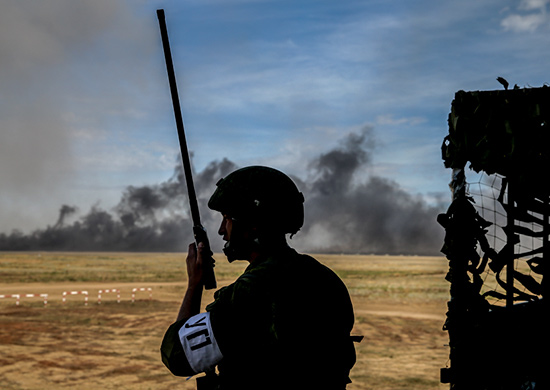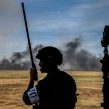
Moscow Tests Network-Centric Military Capability in Kavkaz 2016
Publication: Eurasia Daily Monitor Volume: 13 Issue: 151
By:

Every year, the Russian Armed Forces stage a large-scale training exercise to serve as the pinnacle of the combat training season. These annual major exercises are held, on a rotational basis, across Russia’s various military districts (MD), which also allows the General Staff to test and assess progress in key areas. This year, the military carried out the strategic command post exercise (strategicheskikh komandno-shtabnykh ucheniy—SKSHU) Kavkaz 2016, held in southwestern Russia on September 5–10. And the preparations and snap inspections prior to staging Kavkaz 2016 focused on testing units in the Southern MD. Among the areas of high interest for the Russian top brass were inter-service coordination, strategic mobility, and examining progress in the system of military manpower, especially in relation to contract personnel. However, the SKSHU also provided an opportunity to further test advances in introducing network-centric military capabilities, which have been an ongoing theme in recent years since former defense minister Anatoly Serdyukov’s (2007–2012) reforms were initiated (Mil.ru, September 14).
At the epicenter of this process was the need to further examine the functioning of the automated tactical-level joint command-and-control (C2) system, (Yedinaya Sistema Upravleniya v Takticheskom Zvene—YeSU TZ). Research and development (R&D) on the YeSU TZ has lasted more than 15 years, encountering multiple design issues requiring correction and modifications. Major-General Aleksandr Chaiko, the commander of the 1st Tank Army, highlighted the use of the YeSU TZ T3 during Kavkaz 2016, explaining that it was tested mainly by the 2nd Motorized Rifle Division, a unit subordinated to the 1st Tank Army. Referring to the system by its design company designation, Sozvezdiye-M, Chaiko noted that successful tests of the automated network-enabled system had increased the speed of commanders’ decision making and markedly improved communications. He added that the YeSU TZ T3 was used from the highest divisional command level down to the lowest soldier participating in the exercise (RIA Novosti, September 11).
Defense ministry tests of the YeSU TZ have featured regularly in Russia’s military exercises. Critics have faulted the system for its high cost, and they pointed to design flaws linked to software glitches and failed efforts to simplify the interface to make it more user friendly. Some detractors even suggested that the General Staff has questioned the YeSU TZ’s survivability in combat. But all of these setbacks now appear to have been overcome. In June 2000, a presidential decree ordered the development of an automated command, control and communications system, with its earliest work rooted in forming the relevant guidance documents, with work later commencing on hardware and software systems. By July 2004, the Joint Concern Sozvezdiye was formed, with overall responsibility for the development of the new automated command and control. State tests began within two years. In 2007–2009, pilot experiments were conducted within the Armed Forces, and this became a prominent feature in strategic-level exercises following the Serdyukov reforms, commencing in late 2008. By 2010, elements of the Sozvezdiye-M were delivered to troops, and in recent years further refinements have improved the system (Russianarms.ru, Accessed September 19).
The immense challenges encountered by designers of the automated C2 system relate to the complexities involved in integrating the various software platforms and systems, developing the hardware and communications systems, unifying systems and subsystems, as well as overcoming the need for trained personnel. The latter led to experiments in the 5th Motorized Rifle Brigade, with officers taught about its characteristics and how the whole system should be operated. However, exercise-level tests appear to have largely focused on redressing any remaining flaws (Army-news.ru, November 23, 2010).
Kavkaz 2016 certainly marks significant progress for the system and holds out the prospect of its wider use in the Armed Forces in the future. General Chaiko noted its profound benefits, with the YeSU TZ offering commanders real-time decision making and transmission to any point where the main effort could be focused on combat. Chaiko explained that the system “cuts the time of the decision,” improving signal transmission and aiding with operational capability in a variety of combat situations. He added that divisional testing of the system, including defensive and offensive measures, was in use during a crossing of the Don River (Topwar.ru, September 11).
Kavkaz 2016 also rehearsed various training features such as air defense, including S-400s, coastal landings as well as sharpened the use of the fledgling reservist system. Moreover, it was timed to coincide with a test launch of an intercontinental ballistic missile (ICBM) by the Strategic Rocket Forces. Commanders also claimed that some of its elements drew upon lessons learned from the military’s experience of conducting operations in Syria. In addition, the chief of the General Staff, Army-General Valery Gerasimov, used a press conference a few days after the exercise to announce plans to enhance the numbers of battalion tactical groups (BTGs) from 66 to 125 by the end of 2018 (see EDM, September 15). These numbers are certainly ambitious. But Gerasimov said the BTGs in the Armed Forces are already “fully manned” by contract personnel (kontraktniki), and presumably the intention is to man all 125 BTGs with kontraktniki; this would fit with the introduction of high-tech Command, Control, Communications, Computers, Intelligence, Surveillance and Reconnaissance (C4ISR) systems (Interfax, September 14; Maxpark.com, September 13).
The centrality of the YeSU TZ T3 to the conduct of Kavkaz 2016 denotes not only progress toward developing nascent network-centric capability in Russia’s Armed Forces, but confirms the underlying unifying driver in the push for greater numbers of trained kontraktniki. Media coverage was scant on the thorny issue of the total costs involved in introducing the system, yet its extension to divisional-level testing during the SKSHU seems to indicate a breakthrough for the military. Since the reforms of 2008–2012, continuity has been most evident in the persistence of top brass interest in adopting C4ISR capability. For the time being, Russian commanders are content to experience improved speed in decision making and in gaining experience in the field in relation to the practical implications of the system. It will take time to fully work out how this shift in technology will actually influence the Russian Armed Forces’ conduct in future military operations.




